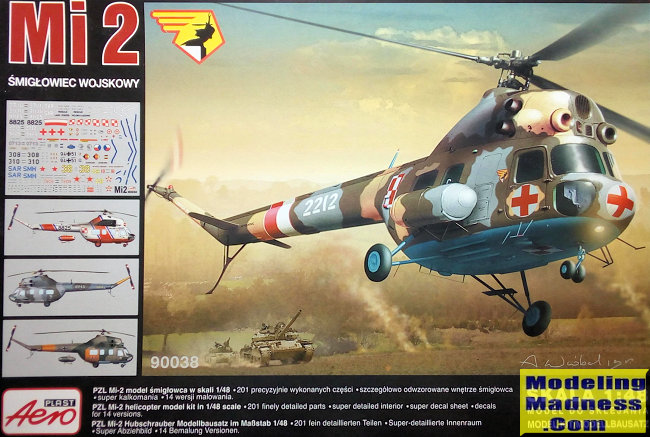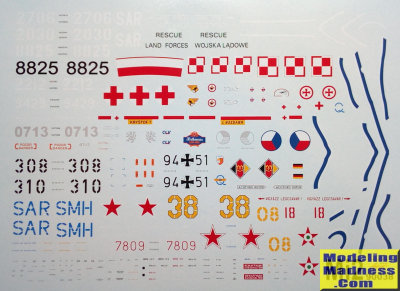
Aeroplast 1/48 Mil Mi-2
| KIT #: | 90038 |
| PRICE: | €40.00 |
| DECALS: | Fourteen options |
| REVIEWER: | Spiros Pendedekas |
| NOTES: |

| HISTORY |
The Mil Mi-2 (NATO reporting name Hoplite) is a small, lightly armed turbine-powered transport helicopter that can also provide close air support when armed with 57 mm rockets and a 23 mm cannon.
The prototype first flew in the Soviet Union on 22 September 1961. After initial development the project was transferred to Poland in 1964. The first Świdnik-built example flew on 4 November 1965 (making this the only Soviet-designed helicopter to be built solely outside the Soviet Union). Świdnik factory also developed fiberglass rotor blades and developed the wide-body Mi-2M, which could seat 10 passengers instead of 8. Most typical role-change kits include four stretchers for air ambulance usage, aero spraying or crop-dusting applications.
In Poland, several specialized military variants were also developed for support or reconnaissance roles, with 23 mm autocannon, machine guns and/or two 57 mm rocket pods, four 9K11 Malyutka anti-tank missiles or Strela-2 AA missiles. A total of 5,497 machines were built, all by PZL-Świdnik, about a third of them for military users.
| THE KIT |
 Aeroplast
is a Polish company, active from 1987 onwards, having produced a variety of
modeling subjects, including planes, helos and armor. In 2013 they presented
their 1/48 Mi-2 line in five editions, practically covering every version and
offering a big number of schemes of this significant helicopter type. My version
was the next to last issued, coming in a medium sized top opening box, with a
very attractive box art of a Polish “ambulance” bird.
Aeroplast
is a Polish company, active from 1987 onwards, having produced a variety of
modeling subjects, including planes, helos and armor. In 2013 they presented
their 1/48 Mi-2 line in five editions, practically covering every version and
offering a big number of schemes of this significant helicopter type. My version
was the next to last issued, coming in a medium sized top opening box, with a
very attractive box art of a Polish “ambulance” bird.
Upon opening the box, I was greeted with no less than 185 light gray styrene
parts, all numbered, arranged in four sprues (a box-size one, two smaller and a
tiny one). Panel lines are very well done: mostly engraved, but also, at places,
raised, in order to replicate the actual looks of the real thing, something that
they successfully achieve. Molding is good, with very little flash, and surfaces
are almost non-pebble (will require some very fine sanding before painting
though).
Cockpit is very well appointed (with all found controls), as is the rest of the
cabin, looking realistically busy. Instrument panel and top consoles feature
raised detail, looking great and seats feature molded on seat belts.
The main and tail rotors are very well executed, as are the engine housing,
intakes and exhausts. No core engines (power sections) are supplied, which is
not a problem, as they are practically invisible upon housing assembly. The
distinctive landing gear and tail skid are also very well done.
Transparencies are superbly molded and crystal clear. A very interesting feature
is that all transparencies can be attached from the outside, including all side
windows. Options include the installation of external stretchers, in order to
make the ambulance version. Instructions are well done, coming in the form of a
glossy A4 booklet printed in color, with the seemingly complex construction
widely spread in 70 simple and very clear steps. Neither internal nor specific
parts (hubs, blades etc) color callouts are given, a definite omission here:
hopefully, the Net will save the day once again! A helpful parts list is also
supplied.
 No less than
14 schemes are provided, including Czech, Heeresfliegertruppe, Polish, Russian
Air Force and Soviet Army. Colors are only given in Gunze codes, meaning having
your conversion charts handy! Decals seem excellently done: well registered,
thin and with minimal carrier film. They are not numbered directly on the decal
sheet, but a well done “numbering list” is provided at the instructions, so
placing those decals will not be much of an issue.
No less than
14 schemes are provided, including Czech, Heeresfliegertruppe, Polish, Russian
Air Force and Soviet Army. Colors are only given in Gunze codes, meaning having
your conversion charts handy! Decals seem excellently done: well registered,
thin and with minimal carrier film. They are not numbered directly on the decal
sheet, but a well done “numbering list” is provided at the instructions, so
placing those decals will not be much of an issue.
The first 25 instruction steps want you to assemble the cabin interior and trap
it between the fuselage halves, as well as attaching all transparencies, sans
the windscreen. Next is the assembly of the main hub with its blades, followed
by assembly and installation of the main gearbox and engines' housing. The tail
is next assembled and attached, followed by the tail planes and the 3-piece tail
skid.
Landing gear is next, followed by attachment of the windscreen, rear rotor and
various 'bits and pieces' (antennas, windscreen wipers and the like).
Consequently, the two optional stretchers are assembled and attached (if you
want to model the ambulance version). Finally, what looks like a winch is
assembled and attached, followed by affixation of the main rotor.
| CONCLUSIONS |
This looks to be a very
good, “modern” kit of this important helicopter, with seemingly accurate shape
and great detailing, especially at the key (for a helicopter) areas of cockpit,
rotors and external "add-ons" (antennas, winch etc). Parts are very well molded,
requiring minimal cleaning before assembly. Clear parts are very well done and
many interesting schemes are provided, the decals looking great.
Instructions are very good, but the absence of internal and specific parts color
callouts is significant. Due to the relatively complex construction and high
parts count, with many of them being small, this kit should be tackled by at
least intermediate modelers, preferably having a couple of “simpler” helo builds
under their belt.
Your other option for a quarter scale Mi-2 is the simplistic looking MisterCraft
(SMER mold), previewed by our Editor here. The
Aeroplast kit deems the MisterCraft obsolete in all aspects but simplicity of
construction. The very sensible price, coupled with the variety of versions and
schemes the Aeroplast is offered, make it a very attractive choice, in order to
model the iconic Mi-2.
Happy modeling!
Spiros Pendedekas
February 2022
Copyright ModelingMadness.com. All rights reserved. No reproduction in part or in whole without express permission.
If you would like your product reviewed fairly and fairly quickly, please contact the editor or see other details in the Note to Contributors.